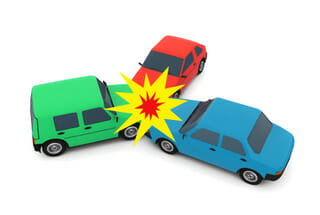How does the PA Fair Share Act affect collecting damages when there are two or more defendants at fault?
Many car accidents and other personal injury cases involve more than one defendant who may be at fault for the accident. Also, many times the defendant will allege that the plaintiff was at fault in causing the accident. When there are multiple parties at fault in an accident, the concepts of contributory negligence, comparative negligence, and joint and several liability may all be involved.
Contributory Negligence in Pennsylvania
What if I’m partially at fault in the accident?

This concept is called “contributory negligence.” The legal concept of contributory negligence is often involved in a rear-end crash if the injured party rear-ended another car. For example, Susie Smith is involved in a car accident when she rear-ends John Doe. John Doe did not have his brake lights working, and he also was stopped in the middle of the road. However, Susie Smith cannot recover if the jury finds that Susie Smith was 51% at fault and John Doe was 49% at fault because Susie Smith should have seen John Doe and should have had her car under sufficient control to be able to stop and avoid the rear-end collision.
In other words, the jury has concluded that Susie Smith was the main cause of the accident.
Comparative Negligence in PA
Multiple parties at fault.
If a plaintiff is 50% or less at fault, a plaintiff may recover in a personal injury lawsuit.
So, in the above example if Susie Smith is found to be 40% at fault, but John Doe is found to be 60% at fault, Susie Smith recovers. This concept is known as comparative negligence – comparing each party’s negligence. If the jury awards $100,000 in damages, the award would be reduced by 40%. Susie Smith will recover $60,000 ($100,000 damages awarded by jury – 40% comparative fault (40,000) = $60,000)
Joint and Several Liability
Who pays damages when there are multiple defendants?
What if there are two or more defendants at fault in the case? For example, Susie Smith rear-ended John Doe when she was forced to swerve over to the left lane because of an illegally parked truck driven by ABC Company. Let’s say the jury finds Susie Smith 20% at fault for not stopping in time, but also finds both John Doe 40% liable for broken brake lights and ABC Company 40% liable for illegally parking. If the jury awards $100,000, both John Doe and ABC Company would be responsible for $40,000 each equaling $80,000.
Pre-2011 Joint and Several Liability
Under the old joint and several liability law in Pennsylvania before 2011, negligent parties were “jointly and severally liable.” Joint and several liability means the plaintiff can recover all the damages from any of the defendants regardless of the percentage of fault. In the above example, if John Doe has no money and cannot pay the judgment of $40,000, ABC Company would be liable for the full $80,000. It would be up to ABC Company to get reimbursed the $40,000 from John Doe, even though ABC Company was only 40% at fault or responsible for $40,000 of the damages. This made it much easier for plaintiffs to collect the entire judgment, even if some of the parties were not financially responsible to pay or had no insurance.
Joint and Several Liability under the 2011 Fair Share Act
How do you collect a judgement against multiple defendants if one defendant does not have insurance or is bankrupt?
Joint and several liability in Pennsylvania has now been amended by The Fair Share Act passed in 2011, which applies to all injuries happening as of June 28, 2011 or later. Under the new law, each defendant will only be responsible for paying a portion of the jury’s verdict or judgment that is equal to its percentage of negligent or liability found by the jury. So, in the example above, if both John Doe and ABC Company are found 40% negligent each, even if John Doe cannot pay the verdict because he had no automobile insurance, ABC Company will only be liable for its 40% of fault or $40,000 (not $80,000 or 80% of the verdict with ABC Company having to seek reimbursement). Thus, Susie Smith may never collect the full verdict of $80,000.
Fair Share Act – Exceptions
There are several exceptions to The Fair Share Act, which will still allow a plaintiff to collect the full amount of judgment against one defendant even if there is more than one defendant at fault for the accident.
The most important exception is if one of the defendants is 60% or more at fault. So, in the above example, if the jury finds John Doe 40% at fault, ABC Company 60% at fault, and Susie Smith 0% at fault, Susie Smith can collect the entire judgment of $100,000 from ABC Company, rather than trying to collect $40,000 from John Doe and $60,000 from ABC Company. This often times is important for example if John Doe has no automobile insurance. If ABC Company is 60% of more at fault; Susie Smith can collect the entire amount from ABC Company of $100,000, rather than collect $60,000 from ABC Company and possibly nothing from John Doe because he did not have automobile insurance.
The other exceptions to The Fair Share Act allowing a plaintiff to collect the entire judgment against one defendant include:
- An intentional tort;
- The release of a hazardous substance under the Hazardous Sites Cleanup Act; and
- Serving alcohol to a visibly intoxicated patron under the Liquor Code.
The Pearce Law Firm
Edith Pearce and her team of lawyers at The Pearce Law Firm have years of experience working for insurance companies before deciding to represent injured victims. They know the “ins and outs” of insurance policies and handling cases with multiple defendants. Hiring an expert personal injury lawyer when multiple defendants may be involved is even more important because of The Fair Share Act and its complexities. Let us figure out how you can collect all the damages you are entitled to when multiple defendants are at fault. Call us today for a free no obligation consultation.






